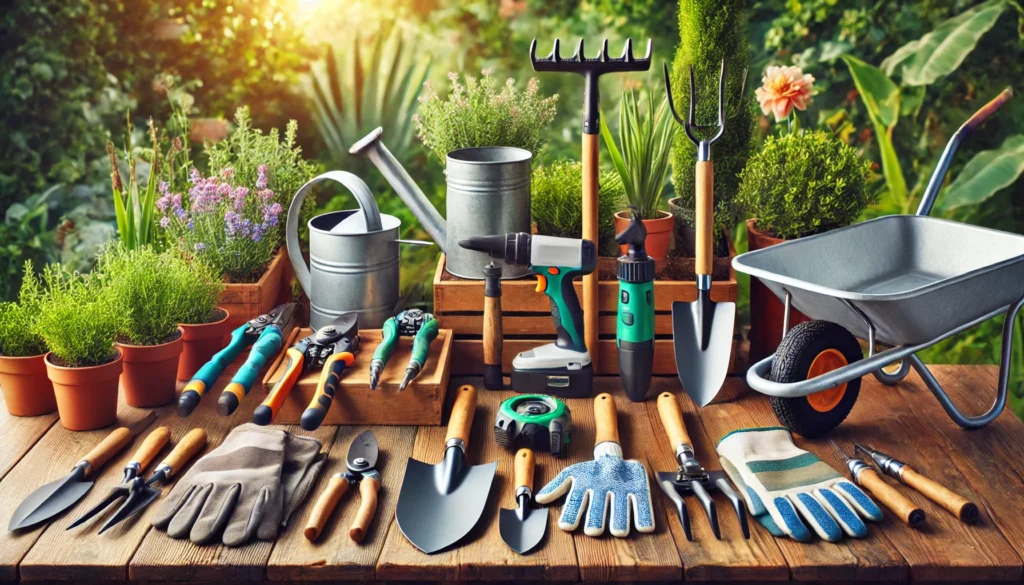Gardening can be incredibly rewarding, but it’s much easier with the right tools on hand. Here are 10 essential tools that every gardener should have, complete with details on how they’re used and the benefits they bring.
Table of Contents
Toggle1. Hand Trowel

Use: A hand trowel is a small, handheld shovel used for digging small holes, transplanting seedlings, mixing soil, and breaking up clumps.
Benefits: Its compact size makes it ideal for precise tasks in tight spaces. Whether you’re planting flowers or herbs, a hand trowel is a versatile tool that’s indispensable for detailed garden work. Look for one with a comfortable grip and rust-resistant blade to withstand repeated use.
2. Pruning Shears (Secateurs)

Use: Pruning shears are used for cutting and trimming plants, removing dead or damaged branches, and encouraging healthy growth.
Benefits: Regular pruning helps prevent disease and promotes the growth of fuller, more vibrant plants. Shears with sharp blades make clean cuts, which heal faster and reduce stress on plants. Choose ergonomic handles to minimize hand fatigue, especially during long gardening sessions.
3. Garden Gloves

Use: Garden gloves protect your hands from cuts, blisters, and exposure to soil and chemicals.
Benefits: Gloves are essential for safe gardening, particularly when working with thorny plants, rough soil, or chemicals like fertilizers. They also prevent your skin from drying out and provide a better grip when handling slippery tools. Durable, water-resistant gloves keep your hands dry and comfortable even in wet conditions.
4. Watering Can or Garden Hose

Use: A watering can or garden hose provides hydration to plants, helping them thrive.
Benefits: The right watering tool ensures plants receive adequate moisture, promoting healthy growth and preventing wilting. A watering can with a fine spout is great for gentle watering in delicate areas, while a hose with adjustable settings is ideal for larger spaces, allowing you to control the flow based on plant needs.
5. Garden Fork

Use: Garden forks are essential for loosening and turning soil, breaking up compacted areas, and mixing in compost or fertilizers.
Benefits: Garden forks help improve soil aeration, promoting root growth and enhancing plant health. A fork with sturdy, sharp tines is perfect for tougher soil and reduces the strain on your hands and wrists. It’s also an excellent tool for turning compost, ensuring organic matter decomposes evenly.
6. Spade

Use: A spade is a larger, flat-bladed tool used for digging, edging, and moving soil, mulch, or compost.
Benefits: With its sharp, flat blade, a spade allows for deep, precise digging, making it perfect for creating planting beds or moving earth in larger areas. A spade with a long handle provides better leverage for more efficient digging, while a D-shaped grip offers control and reduces hand fatigue during extended use.
7. Wheelbarrow

Use: A wheelbarrow makes it easier to transport soil, plants, tools, and other heavy items around the garden.
Benefits: Wheelbarrows save you time and effort by letting you carry multiple items at once, reducing the number of trips needed. They’re particularly useful for larger gardens where heavy lifting is required. Look for a wheelbarrow with a sturdy frame and stable wheels, as these are easier to maneuver and provide better balance.
8. Garden Rake

Use: A garden rake is used to gather debris, level soil, and break up clumps in planting beds.
Benefits: Garden rakes are essential for keeping the garden clean, helping to remove leaves, rocks, and other debris. A rake with metal tines is more durable for heavier work like leveling soil, while a lightweight leaf rake is perfect for cleaning up fallen leaves. Using a rake also improves soil texture, making it more hospitable for planting.
9. Weeder

Use: A weeder is a specialized tool for removing weeds from the roots, preventing regrowth.
Benefits: Weeding is crucial for plant health, as weeds compete with plants for nutrients, water, and sunlight. A weeder with a pointed end allows you to dig out weeds from deep within the soil, ensuring they don’t grow back. This tool is especially helpful for targeting stubborn, invasive weeds without disturbing nearby plants.
10. Garden Kneeler or Cushion

Use: Garden kneelers or cushions offer a padded surface to kneel on, protecting your knees and adding comfort during tasks close to the ground.
Benefits: Kneeling pads reduce strain on your knees and lower back, making gardening more comfortable, especially during prolonged tasks. Some garden kneelers double as a small bench, allowing you to sit while working. Waterproof, durable cushions provide longevity, so you can rely on them season after season.
Final Thoughts
Equipping yourself with these 10 essential gardening tools will streamline your gardening process and make each task easier and more enjoyable. High-quality tools are an investment in the health and beauty of your garden, providing the support needed to cultivate thriving plants and vibrant blooms. Whether you’re tending to flowers, growing vegetables, or simply maintaining your outdoor space, these tools are the foundation for successful and satisfying gardening.







